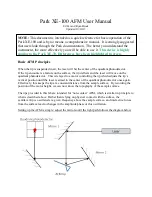
4
Fig. 1 The quality of the image generated in a confocal LSM is not
only influenced by the optics (as in a conventional microscope), but
also, e.g., by the confocal aperture (pinhole) and by the digitization
of the object information (pixel size). Another important factor is
noise (laser noise, or the shot noise of the fluorescent light).
To minimize noise, signal-processing as well as optoelectronic and
electronic devices need to be optimized.
Introduction
Following a description of the fundamental differences
between a conventional and a confocal microscope, this
monograph will set out the special features of the confocal
LSM and the capabilities resulting from them.
The conditions in fluorescence applications will be given
priority treatment throughout.
Imagegeneration
The complete generation of the two-dimensional object
information from the focal plane (object plane) of a confo-
cal LSM essentially comprises three process steps:
1. Line-by-line scanning of the specimen with a focused
laser beam deflected in the X and Y directions by means
of two galvanometric scanners.
2. Detection of the fluorescence emitted by the scanned
specimen details, by means of a photomultiplier tube
(PMT).
3. Digitization of the object information contained in the
electrical signal provided by the PMT (for presentation,
the image data are displayed, pixel by pixel, from a digital
matrix memory to a monitor screen).
Object
Resolution
Ideal optical theory
Image
Digitization pixel size
Pupil illumination
Resudial optical
aber
ations
Confocal apertur
e
No
ise
Detector
, laser
, electr
onics,
photons (light; quantum noise)
Summary of Contents for LSM 880
Page 1: ...LSM 880 LSM 880 NLO Operating Manual October 2014 ZEN 2 black edition...
Page 650: ......
Page 678: ......
Page 687: ......
Page 688: ......













































